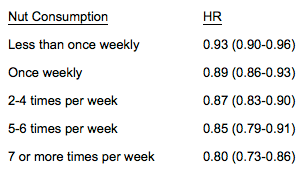Publication
Article
Family Practice Recertification
Eating Nuts Regularly Can Lower Risk of Cardiovascular Disease, Cancer
Author(s):
Nuts should be given their own small space on the "MyPlate" in light of their solid evidence-based recommendation for daily consumption.
Kimberly Zoberi, MD,
and Frank J. Domino, MD
Review
Bao Y, Han J, Hu FB, Giovannucci EL, Stampfer MJ, Willett WC, Fuchs CS. Association of nut consumption with total and cause-specific mortality. N Engl J Med. 2013 Nov 21; 369:2001-11. http://www.nejm.org/doi/full/10.1056/NEJMoa1307352.
Study Methods
In this study, combined data were obtained on 76,464 female participants in the Nurses’ Health Study (NHS) and 42,498 male participants in the Health Professionals’ Follow-up Study (HPFS) to determine whether nut consumption correlated with all-cause mortality. Food-frequency questionnaires on the consumption of various foods, including nuts, were sent out every 2-4 years to participants.
Hazard ratios (HRs) were adjusted for age, and multivariate models were adjusted for multiple known or suspected predictors of death, including age, physical activity, smoking status, alcohol consumption, consumption of fruits and vegetables, and other risk factors.
Results and Outcomes
The study’s primary endpoint of all-cause mortality was significantly lower in subjects who consumed nuts than those who did not. Additionally, the multivariate-adjusted HRs found:

The findings remained significant for all levels of nut consumption, even when they were broken down by gender.
The authors also analyzed the HRs for all-cause mortality broken down by type of nut. For both males and females, they found an HR for mortality of 0.86 (0.82-0.89) for any nut consumption, 0.88 (0.84-0.93) for peanuts, and 0.83 (0.79-0.88) for tree nuts. Additionally, those who consumed nuts regularly had a lower body mass index (BMI) than those who did not.
Several specific causes of death were also negatively correlated with nut consumption, although the findings depended on the type of nut consumed. Concerning death from heart disease, the HR was 0.74 (0.68-0.81) for any kind of nuts consumed 2 or more times weekly versus no nut consumption, which was similar across the subgroups of peanut and tree nut consumption. Regarding cancer death, the HRs were also significantly lower for the consumption of any kind of nut and tree nuts, but not for peanuts.
There were also significant reductions in mortality from respiratory disease and kidney disease among peanut consumers. Overall, death from specific diseases appeared to show a dose-dependent effect.

Conclusion
Using 2 large cohorts, this study found any level of nut consumption was inversely correlated with all-cause mortality. Additionally, death from all causes or heart disease was significantly reduced regardless of the type of nut consumed. Reductions in deaths from cardiovascular disease (CVD), respiratory disease, and cancer were dose dependent with greater benefit seen in those who consumed more servings of nuts.
Commentary
Although many may feel there is a constant stream of new, “miracle cure” interventions to prevent various diseases, this study’s conclusions were based on thousands of patients over years of follow-up.
The findings support a simple dietary intervention that would have a significant impact on population health. As always, a challenge remains in motivating patients to add more servings of nuts to their diets. Patients with the greatest motivation to implement dietary changes, such as those with a personal or family history of heart disease or cancer, may be most willing to make this change.
There are few barriers to implementing this important, inexpensive, and potentially enjoyable form of disease prevention. First, patients may simply be unaware that any kind of nut intake is strongly correlated with lower overall mortality and death from heart disease, and that specific kinds of nuts may reduce mortality from cancer, respiratory disease, and kidney disease. Adding this information to our general dietary advice may motivate patients who are already trying to improve their diets, so consider tacking “eat nuts daily” onto your reminder to “increase your consumption of fruits and vegetables.”
Although patients often believe nuts are high in fat and calories, this study contradicts that concern, as it found those who consumed nuts had a lower BMI. While causation cannot be inferred, we can trust the body’s regulatory mechanisms somehow account for the calories and fat in nuts, since the overall effects are positive. This study similarly contradicts concerns regarding an association between fat intake and the development of heart disease, as high-fat nuts were shown to be beneficial in lowering the risk of CVD.
Out of fear for nut allergy, it is unlikely for an increase in nut consumption to occur at a younger age. While this is an important concern for the small number of affected individuals, it is also a detriment to the population as a whole. Instead of getting school-aged children accustomed to the idea of reaching for nuts as a snack, they may learn to avoid almonds, walnuts, and even peanut butter.
In its current “MyPlate” guidelines, the US Department of Agriculture (USDA) placed nuts in the “protein” category alongside meat, fish, and eggs, which may lead consumers to incorrectly view nuts primarily as a source of protein and equivalent to meat in nutritional profile. This erroneous conclusion would result in a missed opportunity, so nuts should be given their own small space on the plate with a solid evidence-based recommendation for daily consumption.
About the Authors
Kimberly Zoberi, MD, is Assistant Professor and Clerkship Director for the Department of Family and Community Medicine at the Saint Louis University School of Medicine in St. Louis, MO.
She was assisted in writing this article by Frank J. Domino, MD, Professor and Pre-Doctoral Education Director for the Department of Family Medicine and Community Health at the University of Massachusetts Medical School and Editor-in-Chief of the 5-Minute Clinical Consult series (Lippincott Williams & Wilkins).





